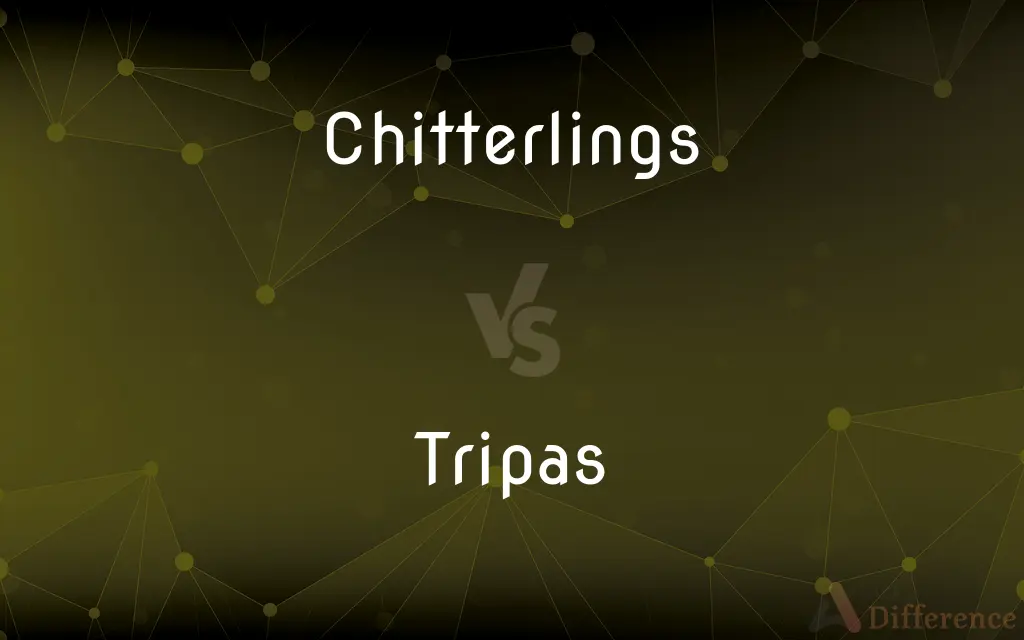Chitterlings vs. Tripas — What's the Difference?
By Tayyaba Rehman — Updated on November 2, 2023
Chitterlings are the small intestines of pigs, traditionally eaten in Southern soul food cuisine, while tripas, in Mexican and Portuguese cuisines, refer to the small intestines of cows, goats, or pigs, often grilled or fried.

Difference Between Chitterlings and Tripas
Table of Contents
ADVERTISEMENT
Key Differences
Chitterlings are a traditional Southern food often associated with soul food cooking, specifically prepared from the small intestines of a pig. Tripas, commonly featured in Mexican and Portuguese dishes, also involve the small intestines but usually of cows or other ruminants and can be prepared differently.
One might enjoy chitterlings during special events or holidays, particularly within African American communities. On the other hand, tripas are often found in everyday cuisine, especially in Hispanic cultures, served in a variety of ways such as in tacos or stews.
Chitterlings are typically cleaned and boiled for several hours and often eaten with vinegar and hot sauce. Tripas are usually cleaned, then grilled or fried to a crisp texture, and served with condiments like salsa.
The preparation of chitterlings can be quite labor-intensive, as they must be thoroughly cleaned due to their initial unpleasant smell. Conversely, tripas also require thorough cleaning but are noted for their quicker cooking time when grilled.
In terms of texture and taste, chitterlings are known for their unique, soft texture and distinct flavor, which can be an acquired taste for some. Tripas, especially when crispy, offer a chewy texture and a rich, intense flavor that's popular in tacos and other dishes.
ADVERTISEMENT
Comparison Chart
Animal Origin
Pig intestines
Usually cow intestines, but can vary
Cuisine
Primarily Southern U.S. and soul food
Mexican, Portuguese, and other Hispanic cuisines
Typical Preparation
Boiled and often served with vinegar and hot sauce
Grilled or fried, served crispy
Texture
Soft and spongy
Chewy or crispy, depending on preparation
Occasion
Often eaten during special events and holidays
Commonly eaten in everyday meals
Compare with Definitions
Chitterlings
Known for their distinctive flavor and texture.
He acquired a taste for chitterlings while living in the South.
Tripas
Often grilled or fried until crispy.
The tripas were fried to a perfect crisp and served with lime.
Chitterlings
A traditional Southern dish.
Chitterlings have been a staple at our family reunions for generations.
Tripas
Small intestines of cows or pigs, used in Mexican cuisine.
He ordered tripas tacos from the street vendor in Mexico City.
Chitterlings
The small intestines of pigs.
Grandma spent the whole day cleaning and cooking chitterlings for the family feast.
Tripas
Known for their chewy texture when cooked.
The tripas had a chewy texture that was surprisingly pleasant.
Chitterlings
Often eaten during holidays like Thanksgiving and Christmas in the U.S.
Every Thanksgiving, we have chitterlings alongside our turkey.
Tripas
Can be prepared in various ways across different cultures.
In Portugal, tripas are a key ingredient in the dish tripas à moda do Porto.
Chitterlings
Can be an acquired taste due to their unique flavor.
She tried chitterlings for the first time and liked them more than she expected.
Tripas
A common ingredient in tacos and other traditional dishes.
For a traditional Mexican experience, we added tripas to our homemade tacos.
Chitterlings
Chitterlings (), sometimes spelled chitlins or chittlins are the small intestines of domestic animals, especially when cooked and eaten. They are usually made from pigs' intestines.
Tripas
Tripas, in Mexican cuisine (known as chitterlings in English-speaking countries), are the small intestines of farm animals that have been cleaned, boiled and grilled. Tripas are used as filling for tacos, and then dressed with condiments such as cilantro, chopped onions, and chile sauce.
Chitterlings
Small intestine, boiled and fried, usually of a pig. Sometimes prepared with hog maws.
Chitterlings
Plural of chitterling
Chitterlings
The smaller intestines of swine, etc., fried for food.
Chitterlings
Small intestines of hogs prepared as food
Common Curiosities
Are tripas only eaten in Mexican cuisine?
No, tripas are also popular in other cuisines like Portuguese.
What animals are tripas taken from?
Tripas can come from cows, pigs, or goats.
How are chitterlings typically served?
Chitterlings are often boiled and served with vinegar or hot sauce.
Can you eat chitterlings without cooking them long?
No, they need to be cooked thoroughly due to safety concerns.
Are tripas considered offal?
Yes, tripas are a type of offal or organ meat.
Are tripas always served crispy?
Often, but they can also be served soft in stews.
How do you clean chitterlings?
They must be rinsed and sometimes soaked to ensure they are clean before cooking.
What are chitterlings?
Chitterlings are the cleaned and cooked small intestines of pigs.
Do chitterlings have a strong smell?
Yes, chitterlings have a strong smell before and during cooking.
Can you buy pre-cleaned chitterlings?
Yes, some stores sell pre-cleaned chitterlings to save time.
Is there a cultural significance to chitterlings?
Yes, chitterlings have a strong cultural tie to Southern and African American culinary traditions.
Do tripas need to be cleaned before cooking?
Yes, like chitterlings, tripas must be cleaned thoroughly.
Are tripas and chitterlings interchangeable in recipes?
Not typically, as they have different textures and flavors.
What's a popular way to eat tripas in Mexico?
Tripas are popular in tacos, often topped with onions, cilantro, and salsa.
Are chitterlings considered healthy?
Chitterlings are high in fat and cholesterol and should be eaten in moderation.
Share Your Discovery

Previous Comparison
Meloxicam vs. Tizanidine
Next Comparison
Sacrum vs. PelvisAuthor Spotlight
Written by
Tayyaba RehmanTayyaba Rehman is a distinguished writer, currently serving as a primary contributor to askdifference.com. As a researcher in semantics and etymology, Tayyaba's passion for the complexity of languages and their distinctions has found a perfect home on the platform. Tayyaba delves into the intricacies of language, distinguishing between commonly confused words and phrases, thereby providing clarity for readers worldwide.
















































